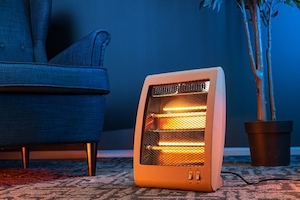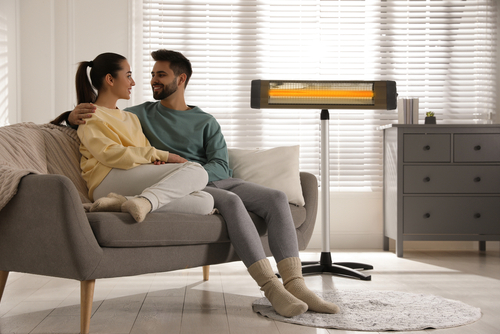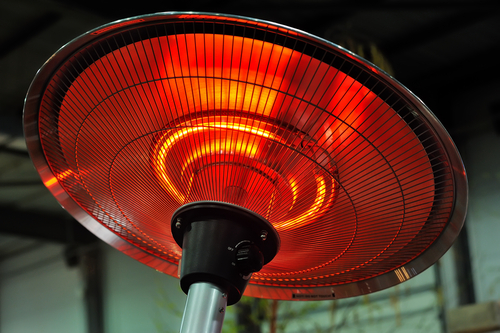Electric Infrared Heater

Figure 1: Electric infrared heater at home
An electric infrared heater is a heating device that uses infrared technology to heat objects and surfaces in a room or outdoor space. They are energy-efficient and can be a good alternative to traditional heating methods, such as gas or electric forced-air systems. This article discusses the definition, working, pros, and cons of electric infrared heaters.
Table of contents
- What is an infrared heater?
- Electric infrared heater specifications
- Types of electric infrared heaters
- Advantages and disadvantages
- FAQs
What is an infrared heater?
Infrared heaters work by emitting electromagnetic waves in the infrared spectrum, which are absorbed by objects and surfaces in the room. As this energy is absorbed, it is converted into heat, warming up the objects. The radiation is invisible to the human eye but can be felt as heat. These waves are similar to the ones produced by the sun and can heat up objects and surfaces directly rather than heating the air around them. This means that infrared heaters can heat a room more quickly and efficiently than traditional heaters, as they do not have to rely on convection to transfer heat from the air to objects and surfaces. Hence, the heat is not lost to drafts or convection, making it more efficient and cost-effective to use. The warmth created also pushes heat around a room via convection. The heated objects also transfer heat to adjacent objects via conduction.
An infrared heater comprises an energy source like a hydrocarbon fuel (natural gas or propane) or electricity which produces infrared heat through a series of coils or burners. This energy radiates out from a heating element, such as a heat exchange tube or ceramic/metallic panel. A reflector directs the energy outward toward the area to be heated. The configuration of setting up an infrared heater can vary, but the components are usually similar across the board. The radiation travels through the air and is absorbed by objects and surfaces in the room, warming them up.
Infrared heater types
Depending on the type of energy used to produce infrared radiation, there are mainly two types of infrared heaters:
- Combustion-fueled: With a gas-powered heater, a burner converts hydrocarbon fuels into infrared heat which centralizes in a heat exchange tube. The radiant heat from the tube reflects outward to focus the heat directionally. In addition, these kinds of heaters can run at lower temperatures and often shows in industrial uses that would be cost-prohibitive to heat with conventional means.
- Electric-powered: A ceramic plate infrared heater converts electricity directly into infrared radiation. As a result, it is extremely efficient, with some companies boasting as much a,s 100% efficiency when it comes to electricity consumption. The plates act as an element that radiates the infrared heat outward and heats the objects within the line of sight of the element. Electric infrared can produce much higher temperatures and produces no emissions such as carbon monoxide or carbon dioxide, unlike hydrocarbon-fueled heaters

Figure 2: An infrared heater radiates the infrared heat outward and heats the objects within the line of sight of the element.
Electric infrared heater specifications
Energy source
Electric infrared heaters have a wattage from 100-1500 watts and above, with an almost 1:1 ratio for efficiency in radiant heat.
Thermostat
Due to the nature of radiant heat, not all infrared heaters have a thermostat. The heated surfaces might be much warmer than the ambient air temperature. In some heaters, a remote thermostat gauges the average temperature of the room to control the heat.
Wheels
Portable infrared heating allows you to direct the focus of the heat with the use of wheels. You can move your heater into the desired position as needed.
Filters
Many infrared heaters do not require filters since they are heating the surface of objects within the focus of the infrared waves, and circulating air is not necessary. Filters combined with fans on some heating units also circulate the air to improve convective heating with radiant heating.
Fans
Used to circulate the air with some heating units to increase ambient air temp quickly.
Heat exchange tube
Part of a hydrocarbon fuel infrared heater, this tube produces radiant heat from combustion and reflects it onto a reflector. Seen more commonly in warehouses and other industrial areas. Capable of generating infrared waves appropriate for large areas, including outdoor heating.
Panels
These infrared panels contain heating coils that produce infrared waves by electricity. Due to the frequency of these infrared waves, they are less intense than other elements and can be hung directly on the walls of homes and offices to safely generate heat.
Reflectors
Reflectors direct the infrared waves toward the area of the room to be heated.
Types of electric infrared heaters
There are a few different types of electric infrared heaters available on the market, including:
- Panel heaters: Panel heaters are thin, flat heaters that can be mounted on walls or ceilings. They are a good choice for heating small to medium-sized rooms and are often used in homes and offices.
- Tube heaters: Tube heaters are long, tube-shaped heaters that can be mounted on walls or ceilings. They are a good choice for heating large spaces, such as warehouses and outdoor areas.
- Patio heaters: Patio heaters are portable heaters that are designed for outdoor use. They can be used to heat patios, decks, and other outdoor spaces.
When choosing an electric infrared heater, it is important to consider the size of the space to be heated, the budget, and energy efficiency goals. Also, compare different models to find the best option for your needs.

Figure 3: A patio heater.
Advantages and disadvantages
Advantages
Electric infrared heaters have multiple benefits when compared to traditional heaters.
- Energy efficiency: Infrared heaters use up to 50% less energy than traditional heating systems, as they do not have to work as hard to heat a room. Also, they do not produce any greenhouse gases or other harmful emissions.
- Versatility: Infrared heaters can heat a variety of spaces, including homes, offices, warehouses, and outdoor areas. They can be placed in a variety of locations, such as on walls or ceilings.
- Cost-effective: Electric infrared heaters typically have a lower upfront cost than other types of heating systems, and they also have lower operating costs since they use less energy.
- Easy installation: Installing an electric infrared heater is a relatively simple process. Most models can be easily plugged into a standard electrical outlet, making them a convenient choice for homes.
Disadvantages
- Safety: The coils of an electric infrared heater can get extremely hot, making the device dangerous to touch, especially around children and pets.
- Stops heating when off: Infrared heaters heat up a room the instant they turn on, but they also stop radiating heat as soon as the devices are switched off. As the air in the room is not actually warmed, the room will lose the built-up heat very quickly.
- Limited warming: The heat produced by an infrared heater can be limited if there is increased motion across the room. The radiant heat travels along a straight line; hence, multiple people may not benefit from an infrared heater at the same time.
Read our solar, portable and radiant floor heater articles for more information on the working of each type.
FAQs
Do infrared heaters warm a room?
Yes, infrared heaters can heat a house and keep the entire building warm.
Is infrared radiation dangerous?
No, infrared radiation is totally safe to use.
How to control the infrared heat
Much like your conventional heat, a thermostat allows you to control the heat output by gauging the temperature of the room.
Can we see infrared heat?
The human eye cannot detect infrared in the visible light spectrum, but animals such as bats, mosquitoes, some species of snakes, and some insects can detect infrared energy.
Does infrared electric heating require ventilation?
Unlike hydrocarbon fuel-powered heaters, electric infrared heating requires no ventilation to allow toxic gasses to escape. It is safe to use in enclosed areas.



